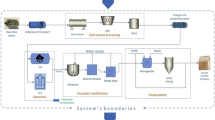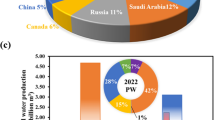Abstract
Life cycle assessment (LCA) is often used to compare alternative process options in terms of their overall impact on the environment to easily identify the most environmentally friendly alternative. In this work, a streamlined LCA study was conducted to assess three different residue utilization schemes for Tongkat Ali (Eurycoma longifolia) extract production. The case study was firstly simulated using a batch process simulation software. The results of mass and energy balances obtained from the simulation software were then subjected to life cycle analysis. By evaluating the different schemes for using the fibrous residue from the extraction process, the potential for environmental process improvement was identified. Overall, use of the residue as process fuel was found to be the most environmentally friendly option. It produces the least emissions and reduces resource usage per unit of product than the other options evaluated.



Similar content being viewed by others
References
Adenan MI (2003) Malaysian herbs and herbal products. In: A two and half day course of herbal and phytochemical processing. CEPP short course notes (Chemical Engineering Pilot Plant, Universiti Teknologi Malaysia, Malaysia)
Allen DT, Shonnard DR (2002) Green engineering: environmentally conscious design of chemical processes. Prentice-Hall, NJ
Athimulam A, Kumaresan S, Foo DCY, Sarmidi MR, Aziz RA (2006) Modelling and optimisation of Eurycoma longifolia water extract production. Food Bioprod Process 84:139–149
Aziz RA, Sarmidi MR, Kumaresan S, Taher ZM, Foo DCY (2003) Phytochemical processing: the next emerging field in chemical engineering—aspects and opportunities. J Kejuruteraan Kimia Malaysia 3:45–60
Aziz RA, Sarmidi MR, Kumaresan S, Foo DCY (2005) Engineering aspects of herbal and phytochemical processing: a Malaysian perspective. Bull Inst Eng Malaysia December issue:10–19
Bishop PL (2000) Pollution prevention: fundamentals and practice. Mc-Graw Hill, New York
Curran MA (1996) Environmental life cycle assessment. Mc-Graw Hill New York
Energy Commission of Malaysia (2003) http://www.st.gov.my/ (access September 2005)
Graedel TE (1998) Streamlined life-cycle assessment. Prentice-Hall, NJ
Guinee JB (ed) (2002) Handbook on life cycle assessment. Operational guide to the ISO Standards. Kluwer, Dordrecht
Harjo B, Wibowo C, Ng KM (2004) Development of natural product manufacturing processes: phytochemical. Trans Inst Chem Eng A 82(A8):1010–1028
Harrison CL (1991) An overview of life cycle analysis. AIChE second topical conference on pollution prevention, August 1991 PA, pp 196–199
Heijungs R, Suh S (2002) Computational structure of life cycle assessment. Kluwer, Dordrecht
Intelligen Inc. (2005) SuperPro Designer® User’s guide. Scotch Plains, NJ
Ismail Z, Ismail N, Lassa J (1999) Malaysian herbal monograph. Malaysian Monograph Committee, Kuala Lumpur
ISO 14040 (1997) Environmental management—life cycle assessment—principles and framework. Geneva
ISO 14041 (1998) Environmental management—life cycle assessment—goal and scope definition and inventory analysis. Geneva
ISO 14042 (2000a) Environmental management—life cycle assessment—life cycle impact assessment. Geneva
ISO 14043 (2000b) Environmental management—life cycle assessment—life cycle interpretation. Geneva
Kaur I, Kumaresan S, Sarmidi MR (2003) A study into the effect of laboratory scale processing parameters and scale up on Eurycoma longifolia water extract yield. Proceedings of the 17th symposium of Malaysian chemical engineers, 29th–30th December 2003, Penang, pp 294–299
Kuo PC, Shi LS, Damu AG, Su CR, Huang CH, Ke CH, Wu JB, Lin AJ, Bastow KF, Lee KH, Wu TS (2003) Cytotoxic and antimalarial beta-carboline alkaloids from the roots of Eurycoma longifolia . J Nat Prod 66(10):1324–1327
Suh S (2001) Missing Inventory Estimation Tool (MIET 2.0). Centre of Environmental Science, Leiden University, The Netherlands
Svoboda S (1995) Note on life cycle analysis. http://www.umich.edu/~nppcpub/resources/compendia/CORPpdfs/CORPlca.pdf. Cited Jan 2006
Von Blottnitz H, Curran MA (2006) A review of assessments conducted on bio-ethanol as a transportation fuel from a net energy, greenhouse gas, and environmental life cycle perspective. J Cleaner Prod 15:607–619
Wang M (1999) GREET 1.5—transportation fuel cycle model. Final Report ANL/ESD-39, Argonne National Laboratory, USA
Wenzel H, Hauschild M, Alting L (1997) Environmental assessment of products. Vol 1. Methodology, tools and case studies in product development. Chapman and Hall, London
Author information
Authors and Affiliations
Corresponding author
Rights and permissions
About this article
Cite this article
Kuan, C.K., Foo, D.C.Y., Tan, R.R. et al. Streamlined life cycle assessment of residue utilization options in Tongkat Ali (Eurycoma longifolia) water extract manufacturing process. Clean Techn Environ Policy 9, 225–234 (2007). https://doi.org/10.1007/s10098-007-0088-5
Received:
Accepted:
Published:
Issue Date:
DOI: https://doi.org/10.1007/s10098-007-0088-5




